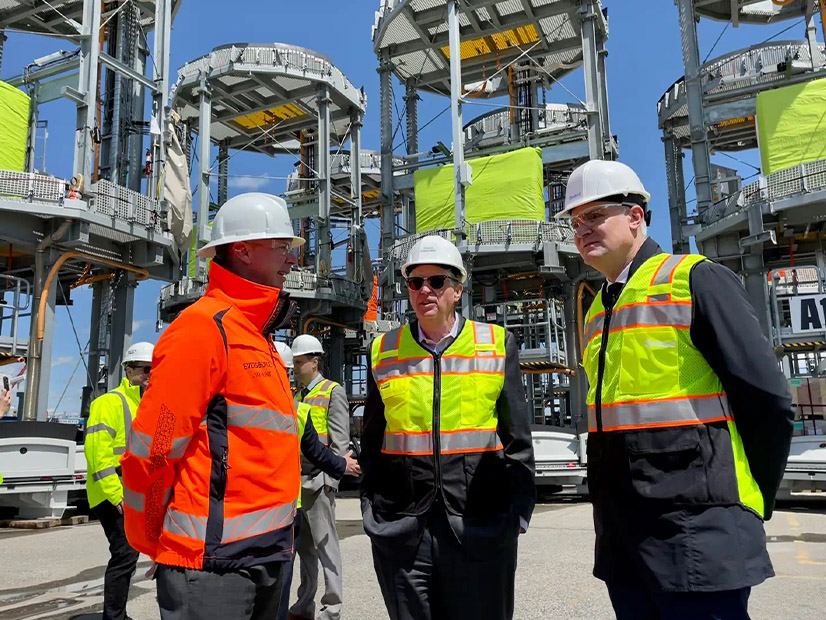
Ørsted on Wednesday reported that earnings from its offshore wind business hit an all-time high in the first quarter of 2023, as increased installed capacity outweighed a slight decrease in average wind speed from the same period last year.
The Danish company is the largest OSW developer in the world. All totaled, including onshore assets, Ørsted generated 8.9 TWh in the first quarter, about 16% more than a year earlier.
The news was tempered by a significant overall decline in profit from year to year because of currency exchange rates and interest rates, Ørsted said.
Green sources accounted for 89% of Ørsted’s first-quarter power generation. Installed renewable capacity totaled 15.48 GW as of March 31: 8.87 GW of offshore wind, 3.46 GW of onshore wind, 2.05 GW of biomass thermal and 1.03 GW of solar.
Ørsted has multiple OSW projects in the works off the U.S. Atlantic Coast, in stages ranging from concept to construction.
On Monday, Ørsted and partner Eversource Energy (NYSE:ES) marked the completion of fabrication of foundation components in Providence, R.I., for its South Fork Wind project and start of fabrication for its Revolution Wind project.
Construction is underway on the South Fork project, which sits south of Rhode Island and will feed up to 132 MW into the New York grid. The components will be loaded soon and shipped to the work site.
South Fork is sometimes referred to as the first large-scale OSW project in the U.S. Vineyard Wind, an 800-MW project under construction off the Massachusetts coast, also claims that distinction. Both are expected to start generating power later this year.
Company and state officials spoke of Monday’s announcement as a milestone not just for South Fork and Revolution but for the OSW industry and for Rhode Island’s place in it.
“A year ago, we mobilized with a blank slate, to build and create a workforce of more than 125 union crafts, 20 support staff and local subcontractors to support groundbreaking wind projects in the state of Rhode Island,” Stephen Zemaitatis Jr., president of general contractor Riggs Distler & Company, said in a news release. “Fast forward a year to the day, and our work is pioneering the development of cutting-edge products and helping chart the path for a more sustainable future. By providing serial construction of advanced foundation components … we are building foundations for both wind turbines and the future of U.S. renewable energy.”
During an investor call Wednesday, Ørsted CEO Mads Nipper said the company is pleased with its OSW financials but is not immune to the price pressures facing the industry.
In Massachusetts, Avangrid (NYSE:AGR) has moved to rebid its 1,200-MW Commonwealth Wind project, saying it cannot be financed with the power purchase agreements negotiated, and the 1,200-MW Shell-Ocean Winds project now known as SouthCoast Wind has indicated it faces the same problems. Ørsted has taken a $365 million cost impairment on its Sunrise Wind project, which will send 924 MW to New York.
“If we do not see value creation being satisfactory … we are prepared to take a different path,” Nipper said.
Meanwhile, the Ørsted-Eversource partnership submitted the only proposal in Rhode Island’s most recent OSW solicitation: the 884-MW Revolution Wind 2. Commenting in mid-March, Rhode Island Energy, which issued the request for proposals with the state, sounded less than thrilled with it, saying careful review would be required before moving forward with it.
A financial analyst asked Nipper if he thought the proposal would be rejected.
“We hope and believe we will be awarded,” he replied. “At this point we are not guessing as to whether there is a risk for that to be resolicited.”
Continued Feedback
In other offshore wind news this week:
- The public comment period closed Monday for the U.S. Bureau of Ocean Energy Management’s proposed Renewable Energy Modernization Rule, which would streamline and modernize regulations first created in 2009 by a predecessor agency to the bureau. The 215 comments posted as of Wednesday ranged from strong resistance by a fishing industry group to a clean energy group citing an urgent need to make OSW development easier, more flexible and more certain.
- A group of New England fishers on Tuesday announced formation of the New England Fishermen Stewardship Association, an advocacy group designed to fight OSW development. NEFSA said it is nonpartisan and the first umbrella organization of its kind in the region. It also said it has the additional mission of fighting “needless regulation” and “social catastrophes imposed by woke regulators.”
- BOEM on Wednesday announced it would review potential environmental impacts that might arise if Maine is granted the offshore wind energy research lease it is seeking in the Gulf of Maine, where it wants to place up to 12 floating turbines. BOEM said comments are due by June 5, and it will consider them as it prepares an environmental assessment for the potential project.


